|
BULB LOG 31 ---- 3rd August 2005
It is that magical time of the year when little parcels of bulbs are flying around between enthusiasts (at least in the Northern hemisphere, our southern friends will get around to it later, or is it earlier?). We have received quite a few very welcome additions to our bulb collection this week, thank you.

Compost mixing
The bulb log reflects what I am doing week by week so I make no apology for telling you about my compost mix again - on a busy day I am making several lots of this mix. On the right; I first put two 10 litre buckets full of 6mm gravel into the mixer, in the wheel barrow is two buckets of loam and one bucket of leaf mould to which I add a mug full (250ml) of bone meal this gives me a 50 litre mix in total. Once it is all in the mixer it only takes about 30 seconds to completely mix the different ingredients together - without the mixer this would take around 10 minutes turning by hand.

Mixing station
Now for a look at my mixing station and the other tools I use. A container with fresh compost, two scoops, one slightly bigger, depending on the size of the pot, a plastic tray to tip the old compost and bulbs into, a couple of sieves, one fine, some plastic saucers to hold the bulbs and a pencil to mark the label.

Plant labels
Clay K. is obviously very observant and noticed that I record dates on my plant labels and asks in the bulb log feedback the reason for this? I have a basic system of record keeping on our plant labels, which are mostly engraved aluminium labels made from cutting up old slats from window blinds, I do use plastic labels as well. Across the top I record the date of sowing the seed (mostly month and year) under that I have a code of initials to remind me of the source of the seed then I draw a line. The plant name is written below this line. On the back of the label I write any further relevant details such as collection site etc. I normally also write in pencil the date/year when I repot the bulbs and also sometimes record the number of bulbs to give me an indication if they are increasing or decreasing in numbers - often nowadays I put a + for an increase, - for decrease and = for the neutral. I am not the very organised type of person who keeps a detailed index of all the bulbs we grow, I was encouraged to t
ry once but it did not last, so I keep a basic record on the plant label.
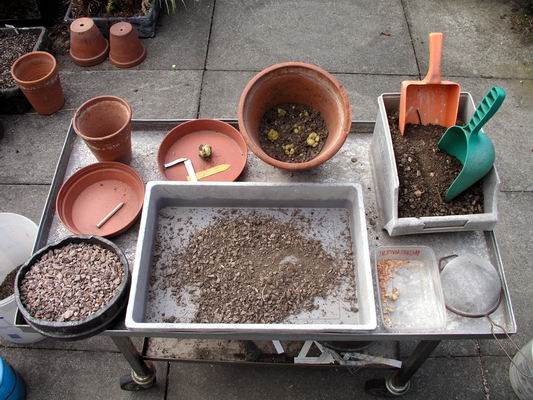
Repotting
I first tip the gravel top dressing into the larger round sieve which holds the gravel but allows fine particles of the compost to pass through. This is especially useful when repotting Narcissus and Crocus that may have seeded into the top dressing because the mesh is just big enough to let these seeds pass through, then I pass that through the smaller sieve which holds onto the seeds and similar sized particles but lets all the very fine dust pass through - I can then sow the seeds with the similar sized particles of fine gravel all together. Back to the pot of frits above, having removed the gravel top dressing I then tip out the compost carefully down to the level of the bulbs, shaking the tray with this compost in quickly reveals if there are any bulbs or bulbils in the upper layers. This compost is then put into bin before I tip out the layer containing the bulbs for sorting. This spent compost is not wasted, I store it in bins to be recycled, taking care what I reuse it for. It is not advisable to reu
se the compost from rice grain frits for repotting other frits as this will lead to a terrible mix up in your bulbs. On this subject I have a theory that if you grow a collection of frits in pots for long enough they will all eventually all turn into Fritillaria hermonis amana or F. acmopetala!! The spent compost gets remixed with the addition of some more leaf mould and bone meal then it is ideal for Erythroniums, Trilliums etc and of course anything non-bulbous.

Mesh for pot
When I am using clay pots I use either zinc or plastic mesh cut to size to cover the drainage holes - I do not add any crocks. This is a pot of Fritilaria pluriflora about which I have heard it said that you cannot grow more than one per pot successfully. I do not find this to be the case we have fine potfuls.
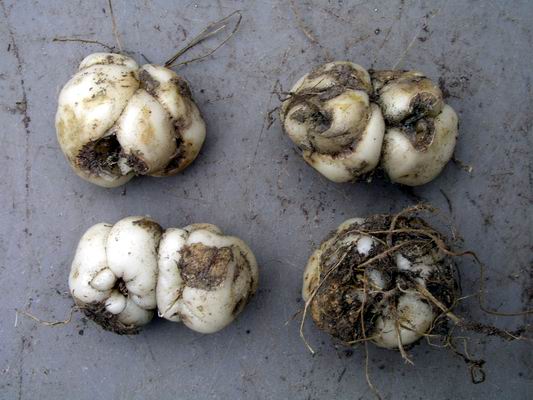
Fritillaria thunbergii bulbs
These are the bulbs of a fine form of Fritillaria thunbergii from China. It has never set seed for us and may even be sterile but every year a single bulb (as seen top left) will form two flowering sized bulbs if grown well like the others in this picture - I wish all frits were as obliging.
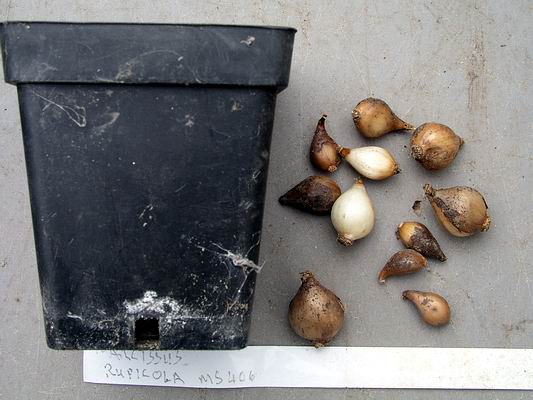
7 cm Plastic pot
One thing I have learnt is that if you are having difficulty growing a bulb: try growing it in a smaller pot. This works for me as I have often observed when repotting that when a particular bulb has gone backwards and as space is always at a premium I consigned it to a 7cm square plastic pot whereupon it starts to recover and grow better. Speaking of plastic pots you must go and read the bulb log feedback in the forum as Paul T. has made a very interesting post on my comments in log 29. What he says is also correct and underlines the need for you to observe your plants and adjust your methods to suit your own climatic conditions. What I tell you works for me in NE Scotland with my compost mix and will give you a good starting place but you must refine it to meet your own environmental conditions. Paul's comment about plastic pots drying out quicker than clays in his conditions is understandable when you take into account that his pots are not plunged or placed on a bed of sand which acts as a buffer to extr
emes of wet or dry. With this taken into account and the fact (I mentioned briefly) that black plastic pots exposed to strong sunlight will heat up quicker than clay pots do, it is not surprising that they can lose moisture quickly.
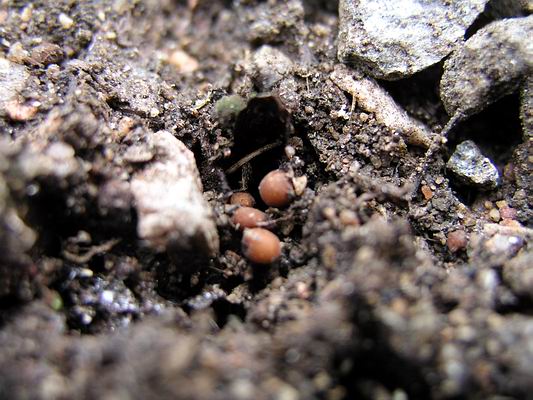
Crocus seeds
Paul also wonders how Crocus caspius seeds get dispersed if they do not push up above the gravel. I am constantly wondering how seeds get dispersed in the wild. Again we have to remember that while my C. caspius (and other crocus species) seed pods stayed under ground, that could be due to our climate, in the wild they may grow and be pushed upwards. I observed, above, that these crocus seeds which had not appeared above the gravel were falling down the hole in the compost left by the withering of the stem. This is not an ideal situation as all the seeds would be in competition with each other as well as with the parent corm. I believe that insects are the dispersal factor in many bulbs including crocus but someone with a lot of patience and financial backing will need to spend years in the field watching to learn the true facts - until then I am happy to speculate.
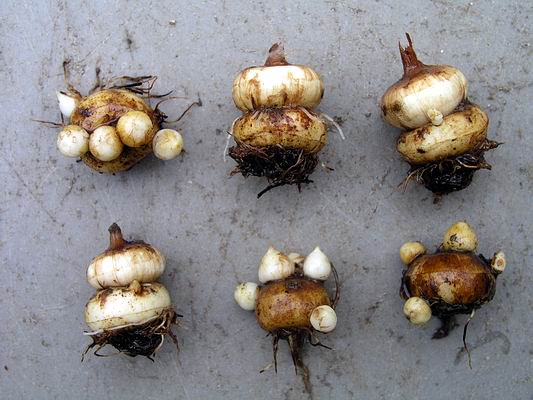
Crocus vallicola corms
I have never observed Crocus corms behaving like this before. These Crocus vallicola corms have not grown well, the old corm should pass all its resources on to the new corm which forms on top of it. Above we have several variations on this - the corm on the top left and the bottom two on the right, had no above ground growth this year at all and have not produced a new corm but a series of cormlets on last years corm. The other three did grow but for some reason the old corm has not withered away as it should have. This is one of several pots of Crocus vallicola that grow side by side in the same frame and all the others grew as normal so what has happened here?
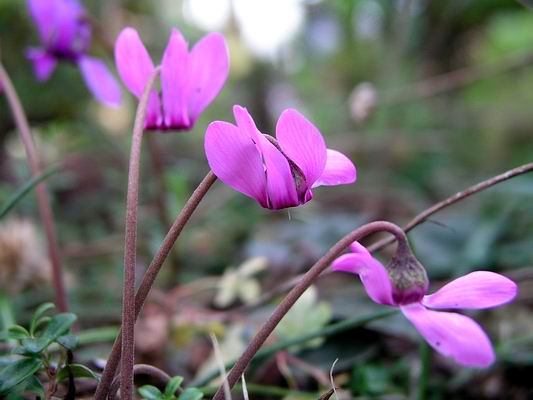
Cyclamen purpurascens
Cyclamen purpurascens has been in flower for some weeks now in a rasied bed which conveniently brings the flowers closer to my nose because it is my favourite smell of all - so calming and relaxing that one sniff relieves all tensions.

Commelina and Lapeirousia
An unlikely pair of bed partners not thought to be hardy are the lovely blue Commelina dianthifolia from Mexico and the south African Lapeirousia laxa. Both have grown in our garden for at least 20 years with out any reintroduction. They both produce seed and can flower within a year of germination and I suspect that the bulbs do not live long but we have a regular supply of these tiny bright flowers in the summer months as self sown seedlings.
^ back to the top ^
|

